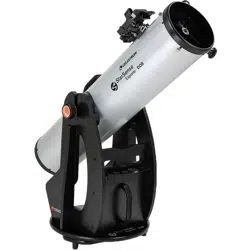Loading ...
Loading ...
Loading ...

ENGLISH I 13
DARK ADAPTATION AND
LIGHT POLLUTION
It takes at least a half-hour for the human eye to become
dark-adapted, so don’t immediately expect to see subtle
detail in faint deep-sky objects as soon as you get outside.
While you are observing, avoid any bright lights (like
going from outside to inside a lighted house) or else your
dark adaption will need time to reset. Use red flashlights
designed for astronomical use, as the red light will not
greatly affect your night vision. The Moon will also affect
your dark adaptation, so if you directly observe the Moon
expect it to take time to regain your night vision.
Local light pollution will greatly diminish the appearance
and contrast of fainter deep-sky objects in the telescope.
Do not expect to see much detail from urban skies. You’ll
get your best views from dark sky locations away from city
or suburban night lighting. Bright objects such as the Moon,
planets, double stars, and bright open star clusters are not
affected by light pollution as much, so they make good
objects for backyard viewing regardless of where you are.
Also keep in mind that the Moon itself can light up much of
the night sky, preventing views of faint objects even from
dark sites. So schedule deep sky observing when the Moon
won’t be visible.
USE OF FILTERS
Experiment with adding optional filters to your setup to
help improve the view. Astronomical filters thread onto the
bottom of your eyepiece and usually come in both 1.25” and
2” formats. Simply remove the eyepiece from the focuser,
thread the filter onto the bottom of the eyepiece’s barrel,
and then reinsert it into the focuser.
There are many useful filters to choose from:
Moon Filter – An essential for viewing lunar details, this
filter cuts down on glare and makes bright objects dimmer.
Variable Polarizer – Like a Moon filter, a polarizer dims your
view. The key difference is that you can customize the extent
of the dimming effect by rotating the polarizer.
Color Filters – Available in a variety of colors, these can
improve contrast when observing planetary details.
Light Pollution Filters – If you are viewing deep-space
objects from urban or suburban skies, these improve
contrast by blocking the “bad” light from local light pollution
and transmitting the “good light” from deep-sky objects.
You’ll notice the greatest improvement in contrast when
observing nebulae
Loading ...
Loading ...
Loading ...
